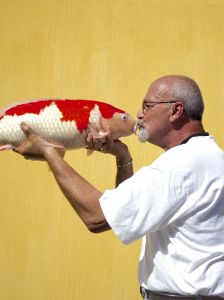Heating your koi pond in the summer?
To some people heating a koi pond anytime of the year may appear unnecessary or a luxury they cannot afford. With koi keeping now a world wide hobby, they are being kept in countries with vastly different climates but koi owners still expect the same results. Koi can survive in water that's just above freezing through to tropical temperatures, but prefer to remain within a stable range between 10C and 30C. In Europe and the US we tend to call koi coldwater fish due to the fact that few people actually heat their ponds but in Asia where koi originate from, water temperatures rarely fall to what would be considered cold here in the UK. In fact some mud ponds in Japan have recorded temperatures of 35C which partly explains their kois' incredible growth rates.
Here in the UK we have very changeable weather especially during the summer months as only last week we were basking in the sun in tropical temperatures and now as I write this it feels cold and its raining (time for a foreign holiday I think). Koi can put up with most temperatures so you shouldn't overly worry with extremes but they don't like sudden changes. In some parts of America they have been having record highs recently which although is not too distressing for koi can cause some problems. Luckily these are relatively easy to remedy with extra aeration and by providing some kind of shade. A waterfall or filter like a Bakki shower can help to cool the water somewhat.
People often talk about minimum depths for a koi pond in terms of preventing the water freezing solid during the winter but actually there are other reasons to designing your koi pond with at least 5ft depth even in warmer places. These are to increase water capacity in your pond because the greater the quantity of water the more stable it becomes to fluctuations in temperature as well as allowing you to stock more koi and provide more room to grow. A large, well designed koi pond when monitored over the year should show a slow, gradual change of temperature when plotted on a graph.
While it's a good idea to create the largest pond you can another way to reduce or even prevent temperature swings is by the use of a heater. There's much debate about heating your koi all year round; it has been suggested koi need a rest period in cool water once a year, but if it's thermostatically controlled, heating can protect against chilling your koi which can induce health problems. It is useful to have the ability to be able to control the water temperature and especially so in a quarantine tank. A kois' immune system is at full strength above 20C and so when treating a sick koi raising the temperature combined with medications is more effective. In fact when buying new koi you should quarantine them for at least a month and temperature control is a useful tool for checking for disease, especially potential KHV outbreaks.
Some people do heat their ponds to increase their kois' growth which can be costly but if done to stabilize temperatures then the heater will not be constantly running. With the cost and availability of solar water heating panels improving this is a method that may become more popular in the future, although for winter heating in Europe their effectiveness may be limited. The most popular methods for heating koi ponds are using specialist electric heaters such as from Profi or Elecro which are plumbed into the pump return or gas boilers which are linked to a heat exchanger. All methods need a reliable thermostat to regulate the water temperature which can be bought from koi equipment suppliers. For a small pond or quarantine tank perhaps the easiest and cheapest heaters to initially buy are electric with gas boilers proving cheaper in the long run on a larger pond.
So along with other tests for water quality it can pay to regularly check water temperatures and if large changes regularly occur these can stress your koi and heating could provide an answer.









0 Comments:
Post a Comment
<< Home